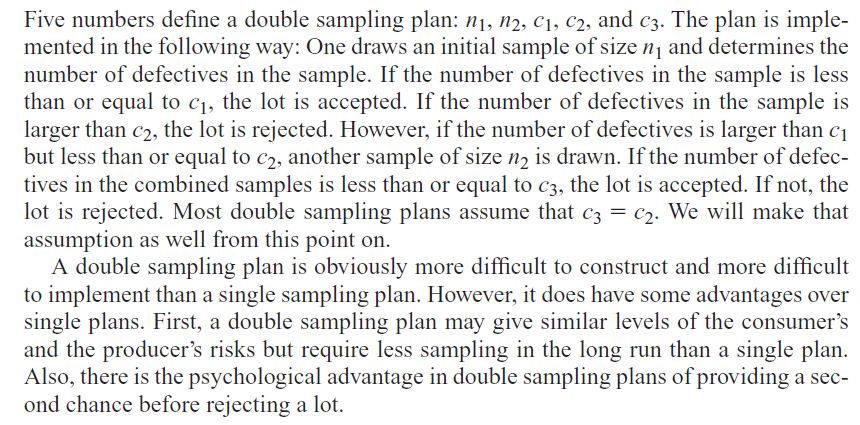Five numbers define a double sampling plan: n1, n2, C1, C2, and c3. The plan is imple- mented in the following way: One draws an initial sample of size n1 and determines the number of defectives in the sample. If the number of defectives in the sample is less than or equal to c1, the lot is accepted. If the number of defectives in the sample is larger than c2, the lot is rejected. However, if the number of defectives is larger than c1 but less than or equal to c2, another sample of size n, is drawn. If the number of defec- tives in the combined samples is less than or equal to c3, the lot is accepted. If not, the lot is rejected. Most double sampling plans assume that c3 = c2. We will make that assumption as well from this point on. A double sampling plan is obviously more difficult to construct and more difficult to implement than a single sampling plan. However, it does have some advantages over single plans. First, a double sampling plan may give similar levels of the consumer's and the producer's risks but require less sampling in the long run than a single plan. Also, there is the psychological advantage in double sampling plans of providing a sec- ond chance before rejecting a lot.
Five numbers define a double sampling plan: n1, n2, C1, C2, and c3. The plan is imple- mented in the following way: One draws an initial sample of size n1 and determines the number of defectives in the sample. If the number of defectives in the sample is less than or equal to c1, the lot is accepted. If the number of defectives in the sample is larger than c2, the lot is rejected. However, if the number of defectives is larger than c1 but less than or equal to c2, another sample of size n, is drawn. If the number of defec- tives in the combined samples is less than or equal to c3, the lot is accepted. If not, the lot is rejected. Most double sampling plans assume that c3 = c2. We will make that assumption as well from this point on. A double sampling plan is obviously more difficult to construct and more difficult to implement than a single sampling plan. However, it does have some advantages over single plans. First, a double sampling plan may give similar levels of the consumer's and the producer's risks but require less sampling in the long run than a single plan. Also, there is the psychological advantage in double sampling plans of providing a sec- ond chance before rejecting a lot.
Holt Mcdougal Larson Pre-algebra: Student Edition 2012
1st Edition
ISBN:9780547587776
Author:HOLT MCDOUGAL
Publisher:HOLT MCDOUGAL
Chapter11: Data Analysis And Probability
Section11.4: Collecting Data
Problem 6E
Related questions
Question
Consider the double sampling plan for Spire CDs presented given.
a. Suppose that the true proportion of defectives in the lot is 10 percent. On average, how many items will have to be sampled before the lot is either accepted or rejected?
b. Suppose that the true proportion of defectives in the lot is 30 percent. On average, how many items will have to be sampled before the lot is either accepted or rejected?

Transcribed Image Text:Five numbers define a double sampling plan: n1, n2, C1, C2, and c3. The plan is imple-
mented in the following way: One draws an initial sample of size n1 and determines the
number of defectives in the sample. If the number of defectives in the sample is less
than or equal to c1, the lot is accepted. If the number of defectives in the sample is
larger than c2, the lot is rejected. However, if the number of defectives is larger than c1
but less than or equal to c2, another sample of size n, is drawn. If the number of defec-
tives in the combined samples is less than or equal to c3, the lot is accepted. If not, the
lot is rejected. Most double sampling plans assume that c3 = c2. We will make that
assumption as well from this point on.
A double sampling plan is obviously more difficult to construct and more difficult
to implement than a single sampling plan. However, it does have some advantages over
single plans. First, a double sampling plan may give similar levels of the consumer's
and the producer's risks but require less sampling in the long run than a single plan.
Also, there is the psychological advantage in double sampling plans of providing a sec-
ond chance before rejecting a lot.
Expert Solution
This question has been solved!
Explore an expertly crafted, step-by-step solution for a thorough understanding of key concepts.
Step by step
Solved in 2 steps with 2 images

Knowledge Booster
Learn more about
Need a deep-dive on the concept behind this application? Look no further. Learn more about this topic, statistics and related others by exploring similar questions and additional content below.Recommended textbooks for you

Holt Mcdougal Larson Pre-algebra: Student Edition…
Algebra
ISBN:
9780547587776
Author:
HOLT MCDOUGAL
Publisher:
HOLT MCDOUGAL

Glencoe Algebra 1, Student Edition, 9780079039897…
Algebra
ISBN:
9780079039897
Author:
Carter
Publisher:
McGraw Hill

College Algebra (MindTap Course List)
Algebra
ISBN:
9781305652231
Author:
R. David Gustafson, Jeff Hughes
Publisher:
Cengage Learning

Holt Mcdougal Larson Pre-algebra: Student Edition…
Algebra
ISBN:
9780547587776
Author:
HOLT MCDOUGAL
Publisher:
HOLT MCDOUGAL

Glencoe Algebra 1, Student Edition, 9780079039897…
Algebra
ISBN:
9780079039897
Author:
Carter
Publisher:
McGraw Hill

College Algebra (MindTap Course List)
Algebra
ISBN:
9781305652231
Author:
R. David Gustafson, Jeff Hughes
Publisher:
Cengage Learning